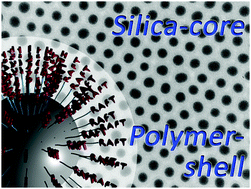Synthesis of silica–polymer core–shell nanoparticles by reversible addition–fragmentation chain transfer polymerization
Abstract
Hybrid

* Corresponding authors
a
Key Centre for Polymers & Colloids, School of Chemistry, The University of Sydney, Australia
E-mail:
sebastien.perrier@sydney.edu.au
b Institute for Chemical Research, Kyoto University, Uji, Kyoto 611-0011, Japan
c Laboratory of Advanced Catalysis for Sustainability, School of Chemistry, The University of Sydney, Australia
Hybrid

 Please wait while we load your content...
Something went wrong. Try again?
Please wait while we load your content...
Something went wrong. Try again?
J. Moraes, K. Ohno, T. Maschmeyer and S. Perrier, Chem. Commun., 2013, 49, 9077 DOI: 10.1039/C3CC45319G
This article is licensed under a Creative Commons Attribution 3.0 Unported Licence. You can use material from this article in other publications without requesting further permissions from the RSC, provided that the correct acknowledgement is given.
Read more about how to correctly acknowledge RSC content.
 Fetching data from CrossRef.
Fetching data from CrossRef.
This may take some time to load.
Loading related content
